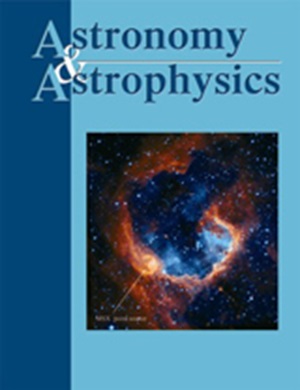Search and analysis of giant radio galaxies with associated nuclei (SAGAN)
IF 5.8
2区 物理与天体物理
引用次数: 17
Abstract
We present the first results of a project called SAGAN, which is dedicated solely to the studies of relatively rare megaparsec-scale radio galaxies in the Universe, called giant radio galaxies (GRGs). We have identified 162 new GRGs primarily from the NRAO VLA Sky Survey with sizes ranging from ∼0.71 Mpc to ∼2.82 Mpc in the redshift range of ∼0.03−0.95, of which 23 are hosted by quasars (giant radio quasars). As part of the project SAGAN, we have created a database of all known GRGs, the GRG catalogue, from the literature (including our new sample); it includes 820 sources. For the first time, we present the multi-wavelength properties of the largest sample of GRGs. This provides new insights into their nature. Our results establish that the distributions of the radio spectral index and the black hole mass of GRGs do not differ from the corresponding distributions of normal-sized radio galaxies (RGs). However, GRGs have a lower Eddington ratio than RGs. Using the mid-infrared data, we classified GRGs in terms of their accretion mode: either a high-power radiatively efficient high-excitation state, or a radiatively inefficient low-excitation state. This enabled us to compare key physical properties of their active galactic nuclei, such as the black hole mass, spin, Eddington ratio, jet kinetic power, total radio power, magnetic field, and size. We find that GRGs in high-excitation state statistically have larger sizes, stronger radio power, jet kinetic power, and higher Eddington ratio than those in low-excitation state. Our analysis reveals a strong correlation between the black hole Eddington ratio and the scaled jet kinetic power, which suggests a disc-jet coupling. Our environmental study reveals that ∼10% of all GRGs may reside at the centres of galaxy clusters, in a denser galactic environment, while the majority appears to reside in a sparse environment. The probability of finding the brightest cluster galaxy as a GRG is quite low and even lower for high-mass clusters. We present new results for GRGs that range from black hole mass to large-scale environment properties. We discuss their formation and growth scenarios, highlighting the key physical factors that cause them to reach their gigantic size.搜索和分析伴核巨射电星系(SAGAN)
我们展示了一个名为 "SAGAN "的项目的首批成果,该项目专门研究宇宙中相对罕见的兆长星区尺度的射电星系,即巨射电星系(GRGs)。我们主要从 NRAO VLA 巡天观测中发现了 162 个新的巨射电星系,它们的大小从 0.71 Mpc 到 2.82 Mpc 不等,红移范围在 0.03-0.95 之间,其中 23 个由类星体(巨射电类星体)托管。作为 SAGAN 项目的一部分,我们从文献(包括我们的新样本)中创建了一个包含所有已知巨射电类星体的数据库,即巨射电类星体目录,其中包括 820 个源。我们首次展示了最大样本的全球红外天文望远镜的多波长特性。这为了解它们的性质提供了新的视角。我们的研究结果表明,GRGs 的射电光谱指数和黑洞质量分布与正常大小的射电星系(RGs)的相应分布并无不同。不过,GRGs 的爱丁顿比值比 RGs 低。利用中红外数据,我们按照其吸积模式对全球红外星系进行了分类:要么是高功率辐射效率的高激发态,要么是辐射效率低的低激发态。这样,我们就能比较它们的活动星系核的关键物理特性,如黑洞质量、自旋、爱丁顿比、喷流动能、总射电功率、磁场和大小。我们发现,与处于低激发状态的活动星系核相比,处于高激发状态的活动星系核具有更大的尺寸、更强的射电功率、喷流动能和更高的爱丁顿比。我们的分析表明,黑洞的爱丁顿比和喷流动能之间存在很强的相关性,这表明存在圆盘-喷流耦合。我们的环境研究显示,10%的黑洞群可能位于星系团的中心,处于密度较高的星系环境中,而大多数黑洞群似乎处于稀疏的环境中。发现最亮的星系团星系是一个GRG的概率相当低,对于高质星系团来说就更低了。我们展示了从黑洞质量到大尺度环境属性的GRG的新结果。我们讨论了它们的形成和成长情况,强调了导致它们达到巨大尺寸的关键物理因素。
本文章由计算机程序翻译,如有差异,请以英文原文为准。
求助全文
约1分钟内获得全文
求助全文
来源期刊

Astronomy & Astrophysics
ASTRONOMY & ASTROPHYSICS-
自引率
27.70%
发文量
0
期刊介绍:
Astronomy & Astrophysics is an international Journal that publishes papers on all aspects of astronomy and astrophysics (theoretical, observational, and instrumental) independently of the techniques used to obtain the results.
 求助内容:
求助内容: 应助结果提醒方式:
应助结果提醒方式:


